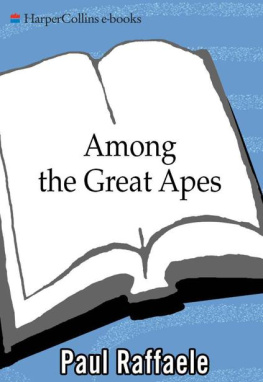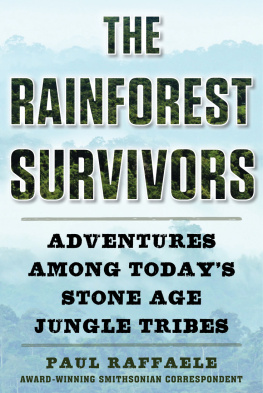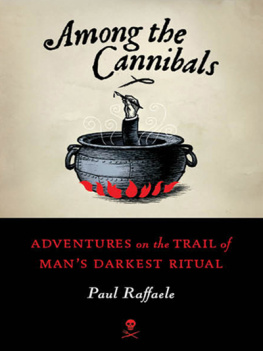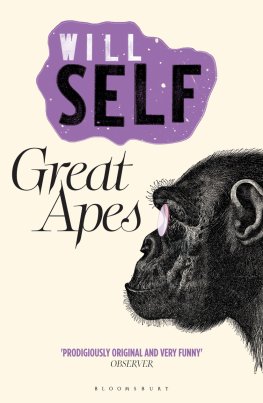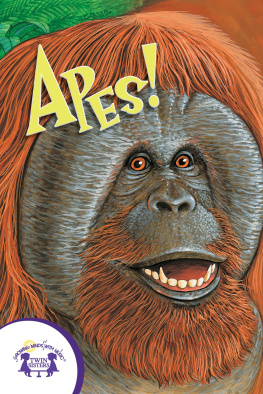Paul Raffaele

For Cecilia, Catherine, Andrew, and Elisabeth
Contents
Gorillas and Guerillas in the Mist
For much of the past century, the artful chimpanzee and
We touch down at Nairobi airport, bleary-eyed, at 4:00 a.m. local
Dave and I left his vehicle at a mud-hut village
More than a decade has passed since Jonathan, Dave, JB,
The border crossing at Goma in eastern Congo is an
Emmanuel de Merode, WildlifeDirects executive director, has just flown in
Months after the deaths of Rugendo and his females, I
In the dark, dank silence of a remote East African
Richard Lynch Garner was the first Westerner to attempt seriously
Far from the African jungle where Imoso rules his Kanyawara
On my way to Kibale from Nairobi, I fly over
On the sixth day that I am with the group,
A world away from the cruelty of the Pyongyang zoo,
Our Long-Lost Cousins
For most people, chimpanzees, orangutans, gorillas, and, for the purists,
By November 2006 the Congolese civil war had largely come
We climb a narrow path up a slope, leap across
Bonobos are among the cleverest of the great apes, and
That chance to meet the worlds most famous bonobo, Kanzi,
The Western Lowland Gorillas
Living in Sydney on the other side of the Earth
Sitting next to me on the flight from Paris to
Dave Greer, the American primatologist from Rwanda, has moved to
Despite the evidence of tool-making by Leah at Mbeli Bai,
Rarest of the Rare
In the cloudy highlands along the border between Cameroon and
That night I visit Yaounds best nightclub, owned by one
On the way back to Yaound, once again a procession
After a couple of hours sleep I go to dinner
An alarm clock wakes us at 6:00. The trackers emerge
Borneos Man of the Forest
Before heading to Borneo, I honor a commitment to go
In 1971, Birut Galdikas journeyed by jet plane, speedboat, and
To be with orangutans in the wild, and witness efforts
There is a hush over the river just before dawn.


Great apes are our wildlife cousins, the animals most like us. This common bloodlinewe share up to 98 percent of our DNAis why they are among the most popular exhibits at zoos around the world. It also explains the enduring popularity of Jane Goodall and Dian Fossey, the two most admired, even romanticized, figures in the world of primate natural science in the past 50 years.
Largely because of their studies, there has been a remarkable change in attitude toward the great apes, especially in the Western world. Until the 1960s, the best-known great apes tended to be depicted in highly contrasting threatening or friendly images. The gorilla was shown as a fierce man-eating monster, the cinematic King Kong, while the chimpanzee was cheeky and always amusing, as with Cheeta in the Tarzan movies. But once primatologists went into the central African jungles and devoted years to studying the great apes behavior in their native habitats, a very different reality emerged.
Over the following decades, through the observations in Africa and Southeast Asia of scores of primatologists spawned by Fossey and Goodall, we have discovered that great ape species each have their separate character. The orangutans are introspective loners; gorillas laid back and largely undemonstrative; the bonobos gleeful hedonists; and chimpanzees the thugs, by far the most destructive and murderous, with males forever fighting tribal battles over territory and personal ranking within the group.
But just as we are beginning to discover the fascinating complexities of our wildlife kins lifestyles, all the great ape species are now threatened with extinction in the wild. Because of widespread poaching, habitat loss, logging, and civil wars in their native lands, all are already on the International Union for Conservation of Natures endangered list. The time when great apes can live unharmed in their native habitats is largely coming to an endand fast. Primatologists estimate that within five decades the only great apes left will be in zoos, sanctuaries, and pockets of wildlife habitat in their native lands, most of them protected by armed rangers.
So, while there was still time, I set out to meet our charismatic cousins in their native habitats in Africa and Asia, in isolated jungles and misty mountain forests in some of the worlds most remote spots. I also visited their captive kin in zoos and sanctuaries across the globe. The result, set down in the following pages, is the most comprehensive eyewitness portrait ever of the great apes in their native habitats.
During my journeys I witnessed not only their dramatic lifestyles but also the very different cultures of the countries where they liveincluding Rwanda, the Central African Republic, Borneo, the Democratic Republic of Congo, Cameroon, and Uganda. The tragedy for most of the worlds great apes is that they live in lands of never-ending turmoil, countries in the grip of corrupt and violent governments.
The struggle for survival of the gorillas, chimpanzees, bonobos, and orangutans in the wild has to be seen within the context of the political, social, and environmental circumstances that surround them, and so those issues are essential to the narrative. Close contact with these great apes also allows us the chance to understand how different they are from other primates, and to appreciate their personalities and intelligence.
Ahead, you will meet unforgettable individuals such as Rugendo, the tragic patriarch of a doomed mountain gorilla family in the Congo, and his feisty young son Noel; Imoso, the dominant male in a clan of violent but fascinating chimpanzees in Uganda; Mlima, a western lowland gorilla, the subject of a four-year ongoing study in a central African rainforest, who was killed by a rival silverback; Jenny, a model orangutan mother, who roams a Borneo jungle as she diligently raises her infants; and Kanzi, the bonobo, or pygmy chimpanzee, whose extraordinary language abilities are being studied at a multimillion-dollar lab in snowy Iowa. Kanzi is possibly the most intelligent nonhuman that we know of on the planet.
You will also meet devoted human primates, such as Kanzis mentor, Sue Savage-Rumbaugh, who has spent three decades researching the remarkable extent of the super-smart bonobos language abilities; American David Greer, a selfless gorilla researcher turned poacher-hunter, who daily risks his life to protect the great apes; Wasse, the greatest of the Bayaka pygmy hunters, who now shuns his tribes traditional practice of killing gorillas; Jean-Marie Serundori, the head ranger who protects the Congo mountain gorillas, defying rebel groups who have killed more than 150 rangers; and the Congolese primatologist Mola Ihomi, who spends up to 10 months away from his family each year studying the behavior of the amazing bonobos in a remote and dangerous jungle.
Valiant efforts are underway to save the great apes before they fall victim to the destruction of their habitats. This is one of the worlds most pressing conservation problems, and yet it is not given the publicity it deserves. The fate of the whales generates 100 times more column inches in newspapers and magazines and far more TV coverage. Yet most of the whale species are in nowhere near as much danger as are most of the great ape species.

